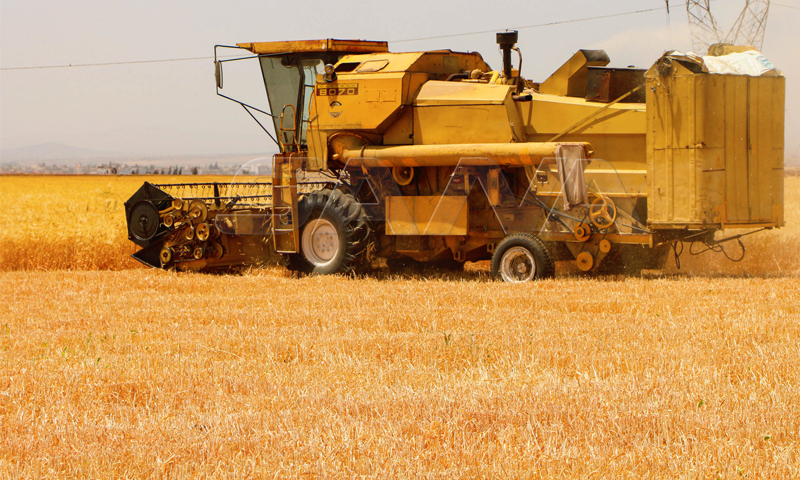



Enab Baladi – Daraa
While the farmer, Mohammad al-Mafalani, 60, was waiting for the harvester to enter his land in the eastern countryside of Daraa city, his dreams were shattered with the withering of his wheat area, which amounts to 100 dunums, as the ears of wheat dried up, and his crop became an area for shepherds at the price of 40,000 Syrian pounds (10 US dollars) per dunum.
The decrease in rainfall during the months of March and April caused the volume of rainfed wheat production in Daraa governorate, southern Syria, to decline.
“It is a drought year,” the farmer tries to describe this year’s lack of wheat harvest on his land by using the local expression used by the area’s residents, used when the rain stops and the agricultural lands become dry.
The lack of rain is reflected in the farmers’ financial loss amid the high cost of production. The fee for plowing a dunum ranges between 25,000 and 35,000 Syrian pounds, as well as the price of seeds, which ranges between 2000 and 2500 pounds, al-Mafalani says.
A rainfed dunum needs 15 to 20 kilograms of seed, while a dunum of irrigated wheat needs between 30 and 40 kilograms of seed.
The exchange rate of the US dollar against the Syrian pound during the past week reached 3,985 pounds, according to the Syrian Pound Today website, which specializes in exchange rates and foreign currencies.
According to the Daraa Agriculture Directorate, large areas of land were affected by the lack of rain at the beginning of the wheat planting season, with 82,000 hectares of land, which will negatively impact production quantities, according to what a former member of an agricultural association told Enab Baladi.
The association member, who declined to be named for security reasons, said that the agricultural sector is a very important mainstay for local livelihoods and is dependent on water resources and climate change.
The area of rainfed cultivation of wheat is equivalent to several times the irrigated wheat crop, according to estimates of a member of the agricultural association.
“Because we did not witness abundant rain this year, especially in March and April, when it did not rain enough to irrigate, the areas of rainfed wheat became outside the production accounts for this year, as they depend on rain,” adds the former official in the agricultural association.
The Daraa Agriculture Directorate was optimistic about the quantities of irrigated and rainfed wheat, as the area of irrigated wheat was estimated at 10,900 hectares, 108 percent more than the plan decided by the Directorate of Agriculture, while the percentage of rain-fed wheat cultivation reached 103 percent of the established plan, which amounts to 82,000 hectares.
Irrigation of the wheat crop is one of the most important obstacles facing the farmer in determining the fate of his harvest, especially after the amount of rain has decreased this year, as one hour of irrigation requires approximately six liters of diesel, and the price of a liter has reached 4,300 pounds in the local market.
At the same time, the Directorate of Agriculture allocated two liters per dunum at the subsidized price of 580 pounds and three liters per dunum at the cost price of 1700 pounds.
“The quantities of diesel distributed by the Daraa Agriculture Directorate are not enough for one irrigation for the crop, which needs at least two irrigations, and the best is three irrigations during the whole season to ensure the productivity of the crops,” according to farmer Jamal, 30, from the western countryside of Daraa.
The delay in delivering the amount of diesel fuel to farmers also contributed to their reluctance to irrigate because the time for watering was missed, as each hour of operating diesel generators costs approximately 30,000 Syrian pounds, in addition to the crop’s need for the process of spraying pesticides in order to combat insects, most notably the Sunn pest.
The Food and Agriculture Organization (FAO), in its report issued in 2021, stated that what Syrian farmers have suffered to secure their basic needs since 2011 had a direct impact on food security in the country, which affects 60 percent of the population, according to the UN estimates. Climatic conditions this year are a source of threat to wheat and barley crops, mainly.
The report added that the crisis in Syria affected the response capacity of the relevant government institutions due to the absence of qualified cadres in the country and the lack of training opportunities to develop the skills of those who remained to be able to face the successive shocks of the agricultural sector.
if you think the article contain wrong information or you have additional details Send Correction